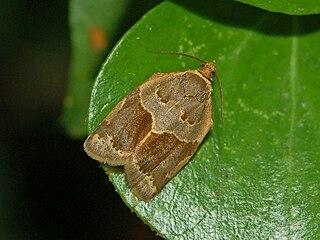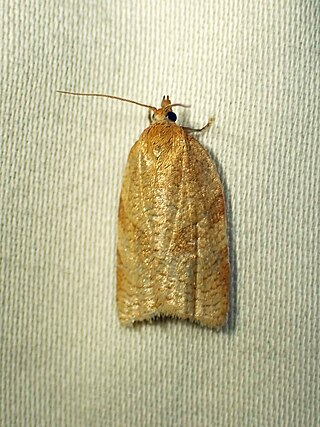
Bactra is a genus of moths belonging to the subfamily Olethreutinae of the family Tortricidae.

Coccothera is a genus of moths belonging to the subfamily Olethreutinae of the family Tortricidae.

Syricoris is a genus of moths belonging to the subfamily Olethreutinae of the family Tortricidae.

Bactra venosana, the nutgrass borer or nutsedge borer, is a moth of the family Tortricidae. It was first described by Philipp Christoph Zeller in 1847. Julius von Kennel provides a full description. It has a wide distribution, from southern Europe, North Africa and Asia Minor to India, Sri Lanka, southern China, Malaya, Australia and into the Pacific where it is found on Java, Borneo, the Philippines, Taiwan, Timor, the Solomons, the Carolines and Fiji. It was introduced to Hawaii in 1925 to control nutsedge. It is now found on Kauai, Oahu, Molokai, Maui, Lanai and Hawaii.
Bactra punctistrigana is a moth of the family Tortricidae. It is known from Namibia, Madagascar, Mozambique, Nigeria, South Africa and Zimbabwe.

Clepsis dumicolana is a moth species of the family Tortricidae. It is found in Spain, France, Italy, Belgium, the Netherlands, Germany, Switzerland, Austria, Slovenia, and the Near East.

Chrysoteuchia topiarius, the topiary grass-veneer moth, subterranean sod webworm or cranberry girdler, is a moth of the family Crambidae. The species was first described by Philipp Christoph Zeller in 1866. It is found in most of North America.

Dioryctria auranticella, the ponderosa pineconeworm moth, is a moth of the family Pyralidae. The species was first described by Augustus Radcliffe Grote in 1883. It is found in western North America from southern British Columbia south to California and Arizona, east to South Dakota and New Mexico.
Bandera binotella is a species of snout moth in the genus Bandera. It was described by Philipp Christoph Zeller in 1872. It is found in North America, including Texas, New Mexico, California, Colorado and Alberta.
Cornesia ormoperla is a species of moth of the family Tortricidae. It is found in Zambia, Zimbabwe, Nigeria, South Africa and the Democratic Republic of the Congo.
Congoprinsia is a genus of moths belonging to the family Tortricidae. It contains only one species, Congoprinsia juratae, which is found in the Democratic Republic of the Congo.

Aphelia alleniana, the wide-striped leafroller, is a species of moth of the family Tortricidae. It is found in North America, where it has been recorded throughout Canada, as far north as Alaska. In the United States, it has been recorded from Colorado, Maine and Montana.

Bactra optanias is a species of moth of the family Tortricidae first described by Edward Meyrick in 1911. It is found in Papua New Guinea, Australia, New Zealand, Java, Tahiti, Sri Lanka, New Caledonia, the Caroline Islands, the southern Mariana Islands, Rapa Iti and Micronesia.

Clepsis moeschleriana is a species of moth of the family Tortricidae first described by Maximilian Ferdinand Wocke in 1862. It is found in Kyrgyzstan, Russia and North America, where it has been recorded from Alaska to Newfoundland, south in the mountains to New Hampshire, Colorado and Utah. The habitat consists of alpine and subalpine areas.

Clepsis virescana, the light brown apple moth, is a species of moth of the family Tortricidae. It is found in North America, where it is widespread in southern Canada and most of the United States. The habitat consists of shrubby open areas and aspen parkland.

Bactra bactrana is a species of moth of the family Tortricidae. It is found on the Canary Islands, Sicily and Malta and in southern Spain, Portugal, southern Italy, France, Greece, Morocco, Algeria, Egypt, Asia Minor, Arabia, Iraq, Iran, the Caucasus, Afghanistan, the Caspian area, Tajikistan, Kyrgyzstan, Uzbekistan, Pakistan, India, the Republic of Congo, Madagascar, Sudan and Gambia.
Bactra blepharopis is a species of moth of the family Tortricidae. It is found in New Caledonia and Australia, where it has been recorded from New South Wales and Queensland.

Agriphila ruricolella, the lesser vagabond sod webworm, is a moth in the family Crambidae. It was described by Philipp Christoph Zeller in 1863. It is found in North America, where it has been recorded from Quebec and Maine to South Carolina, west to Arizona and north to Alberta. The habitat consists of grasslands, weedy areas, fields and cultivated areas.

Endothenia hebesana, the verbena bud moth, is a species of moth of the family Tortricidae. It is found in North America, where it has been recorded from Massachusetts, New York, New Jersey, Pennsylvania, Maryland, Virginia, North Carolina, Florida, Texas, Ohio, Indiana, Missouri, California, British Columbia, Alberta, Manitoba and Ontario. The habitat consists of black spruce-sphagnum bogs.

Bactra furfurana, the mottled marble, is a moth of the family Tortricidae described by Adrian Hardy Haworth in 1811. It is found in the Nearctic and Palearctic realms.















